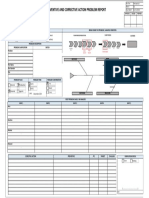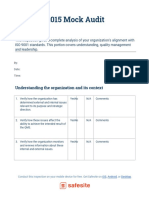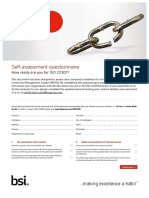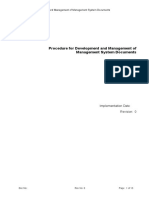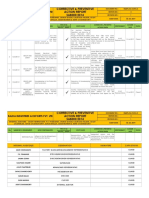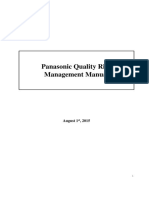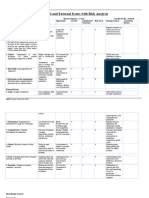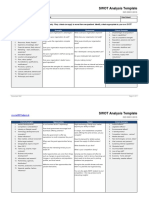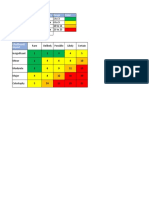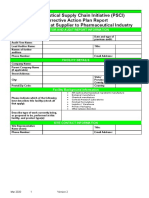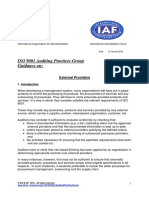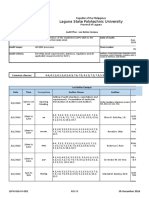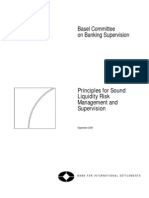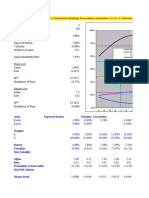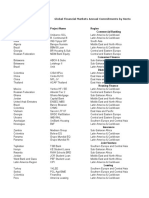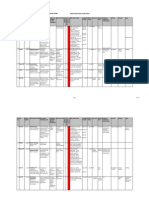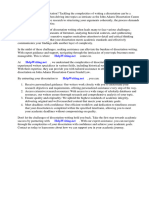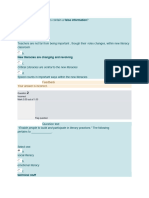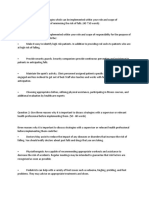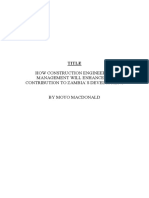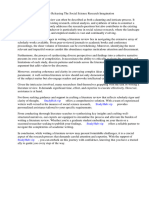Risk Assessment
Risk Assessment
Uploaded by
morrisonkaniu8283Copyright:
Available Formats
Risk Assessment
Risk Assessment
Uploaded by
morrisonkaniu8283Copyright
Available Formats
Share this document
Did you find this document useful?
Is this content inappropriate?
Copyright:
Available Formats
Risk Assessment
Risk Assessment
Uploaded by
morrisonkaniu8283Copyright:
Available Formats
Risk Analysis Scoresheet
External Value Score Problem Counter Measure
Dependency Factor
Multiple vendors / Y = 2, N = 0 Coordination. Ensure adherence to standards, both technical and managerial.
contractors? Emphasize the importance of regular status reporting.
Poor vendor support? Y = 1, N = 0 Time wasted waiting for response to Impose contractual constraints/safeguards. Request documentation in
queries or due to rework arising from advance. Ensure effective account manager. Identify a user group
mistaken assumptions made by the with other clients.
project team in the interim.
Critical dependence Y = 2, N = 0 May miss milestones waiting for Ensure suppliers are aware of schedule commitment. Request interim
on external deliverables. status reports and review of partially complete deliverables so that the
suppliers? project team can verify the supplier's estimates of the effort to go.
Impose contractual obligations.
Number of inter- < 3 = 0, 3-5 = 3, > 5 Time wasted awaiting completion of Have a co-ordination project with the critical path specified in terms of
project =5 other projects not within the stage projects. Recommend a strategic / architectural plan is produced.
dependencies? manager's control.
Overlapping scope Y = 3, N = 0 Parallel, or duplicate, development of Establish cross-project standards to ensure consistency. Establish
with other projects? similar areas with different change control procedures to manage the different changes proposed
approaches causing confusion and by different systems. Recommend a strategic/architectural plan is
irritation to the user. produced.
Contradicts LRSP Y = 10, N = 0 Project initiated for no justifiable Ensure Project Board and Strategy Committee are aware of the
direction? reason, e.g., political. situation.
Plan requires Y = 2, N = 0 Time and expense Investigate training current resources. Plan gradual take on to allow for
extensive recruitment familiarization and training. Investigate viability of using short term
of resources? experienced contractors.
External Dependency 0 Low Risk
Total
51105620.xls / External 1 02/07/2011
Risk Analysis Scoresheet
Organizational Value Score Problem
Factor
Number of user Equal to number of Not obtaining consensus.
areas and decision user areas / decision
makers? makers.
Multiple geographical Equal to number of Time to distribute deliverables and
locations? geographical areas co-ordinate activities.
divided by the
number of
implementation sites
Previous user IS Y = 0, N = 1 Unrealistic expectations. Lack of
project experience? communication. Lack of knowledge
of roles and commitment.
Size of departments < 200 = 0, 200-500 = (This is the number of people whose
impacted? 1, 500-2000 = 3, > function will be changed as a
2000 = 5 consequence of the new system)
Complexity of requirements and
possibility of conflicts.
Inappropriate level of Y = 10 N = 0 When a problem arises, the sponsor
sponsorship? may not have the authority, or
perspective, to support the project
adequately.
Key users Y = 5, N = 0 Lack of understanding of
unavailable? requirements. Lack of involvement of
users in production of deliverables
with a consequential lack of
commitment to project.
Organizational Y = 2, N = 0 Resistance to system by
changes required (in organization.
terms of structure /
responsibility)?
Level of changes High = 3, Moderate Users inadequately prepared for a
required to user = 2, Low = 1 successful implementation and
procedures? handover.
Are users dually Y = 0, N = 3 Lack of commitment to assuring
involved in the quality of technical deliverables and
management and to plan.
execution of the
project?
Will extensive Y = 2, N = 0 Inadequate budget and time frame
education be for training.
required to facilitate
use of the system?
Organizational Total 0 Low Risk
51105620.xls / Organization 2 02/07/2011
Risk Analysis Scoresheet
51105620.xls / Organization 3 02/07/2011
Risk Analysis Scoresheet
Counter Measure
Identify key representative. Establish
decision making
process/responsibilities.
Select a pilot implementation site
then a phased implementation.
Establish focal point for development
activities.
Schedule briefing and training
sessions early in project. Increase
user involvement/participation.
Training requirements and
implementation logistics. Consider
phased implementation if self-
contained increments can be
identified. Plan implementation as
early as possible.
Extend project board to include a
more appropriate sponsor.
Use techniques which are less
dependent on user input, e.g.,
relational data analysis rather than
data modeling. Use user
representative on Project Board to
"encourage" user participation.
Extend review activities.
Hold briefings throughout project on
what the repercussions will be.
Increase user involvement. Obtain
top management commitment.
Increase level of user training, use of
prototypes and presentations of the
new procedures, both system and
manual.
Increase user participation in the
technical activities by use of JAD,
and the interactive sessions, to
gather information and create
models. Determine user roles in the
project organization (Project Board,
Project Coordinators).
Include prior walkthrough of the
training sessions and materials to
gain commitment from user
management.
51105620.xls / Organization 4 02/07/2011
Risk Analysis Scoresheet
51105620.xls / Organization 5 02/07/2011
Risk Analysis Scoresheet
Planning Factor Value Score Problem
Dependent on scarce Y = 5, N = 0 Competition for resources or
resources / skills? personnel with appropriate skills.
Complex task Y = 3, N = 0 Critical dependencies unknown,
dependencies? increased chance of slippage.
Critical Y = 5, N = 0 May have to cut back on quality
implementation date? and/or functionality, or project
discarded if date missed.
Informal control Y = 5, N = 0 Inaccurate Project Status information.
procedures?
Effort versus elapsed Effort time/Elapsed The greater this ratio, the greater the
time? time number of simultaneous tasks.
Increased staff associated with
development and associated
overheads.
Number of major < 3 = 1, >= 3 = 3 Managing Interfaces.
subsystems?
Subsystem more Y = 2, N = 0
than 3 elapsed
years?
Subsystem more Y=2 N=0 Increased chance of slippage due to
than 12 elapsed possible changes in requirements or
months? scope over longer elapsed time.
Level of confidence? >85% = 1, <85% = 3 Level of planning experience of
unknowns within the plan may make
estimates low.
Key dates set by Y = 0, N = 3 No commitment to plan,
project team from the unachievable date.
plan?
Experience of project High = 0, Moderate Plans may not exist. Control
manager? = 1, Low = 3, None procedures may not be adequate.
allocated = 4
Planned resources Y = 0, N = 5 New plan will be required to fit with
available? maximum resource constraint or
project could be canceled/postponed.
Planning Factor Total 0 Low Risk
51105620.xls / Planning 6 02/07/2011
Risk Analysis Scoresheet
Counter Measure
Make resource requirements known
as early as possible.
Increase level of planning. Tighten
project control.
Verify significance of date. Ascertain
which portions of system are required
for that date. Consider incremental
development. Plan and control at
detailed level.
Encourage take on of formal controls
by training and provision of project
management software.
Increase control procedures and
introduce additional level of
management. Divide into achievable
sub-systems.
Have a co-ordination project.
Establish overall architectural plan.
Minimize project interdependencies.
Increase the number or control
points.
Increase the number or control
points.
Ensure management tolerances and
contingencies are identified.
Verify significance and justification for
dates. Produce a plan.
Provide training and support from
experienced project manager.
Increase involvement by Project
Board.
51105620.xls / Planning 7 02/07/2011
Risk Analysis Scoresheet
Business Case Value Score Problem
Factor
Major increase in Y = 3, N = 0 If greater than +/-5%, then likely to
costs possible? miss stage end targets.
Evolving business Y = 5, N = 0 Do not know where project should be
requirements? heading, difficulty in justification,
significant rework likely.
Incomplete definition Y = 5, N = 0 Cannot estimate effort as a lot of
of scope / rework is likely.
requirements?
Ill-defined benefits? Y=2, N=0 Difficult to select optional solution,
potential for project being canceled.
Lead time for return Twice development May never achieve pay-back.
on investment time = 2, Five times
or more the
development time = 5
Mission critical Y = 5, N = 0 Business may fail if project fails.
system?
Fundamental to IS Y = 5, N = 0 Foundation system impacting other
strategy? developments.
Business High = 1, Low = 3 System perceived as belonging to
commitment to I.S. department.
development?
Business Case Total 0 Low Risk
51105620.xls / Business Case 8 02/07/2011
Risk Analysis Scoresheet
Counter Measure
Set appropriate tolerance levels.
Investigate mechanisms for further
controlling costs.
Use iterative development approach.
Establish detailed scoping study.
Increase user involvement.
Involve more senior user
representatives. Establish detailed
scoping study. Increase time spent
in analysis.
Use CRA to help define tangible
benefits. Establish focused sessions
with user to evaluate benefits.
Reduce scope of system to include
most profitable segments.
Increase planning and level of
control.
Increase planning and level of
control.
Hold assessments requiring user
sign-off. Increase user involvement.
Produce detailed Business Case.
51105620.xls / Business Case 9 02/07/2011
Risk Analysis Scoresheet
Technical Value Score Problem Counter Measure
(Environment)
Factor
Inappropriate Y = 2, N = 0 Required tools unavailable. Review tools and associated
development tools? justification. Evaluate other
productivity areas.
New / unfamiliar Y = 5, N = 0 Time required for learning curve Conduct training. Recruit
technology? during development. experienced staff. Obtain vendor
Stable development Y = 0, N = 5 Lost information. Time required for support.
Document in standard format as
team? handover. project progresses. Increase
attendance at reviews to spread
knowledge.
Low team knowledge Y = 1, N = 0 Increased reliance on users. Increased user participation.
of business area? Increase frequency and formality of
Project team skills? Expert = 0, Balanced If the balance of expertise is low, reviews.
Increase the frequency of Quality
= 1, Trainee = 5. then there is an increased risk of Assurance Reviews and Project
defects. Checkpoints. Include experienced
staff as specialized technical support.
Account for experience levels when
planning.
Use of development Y = 0, N = 2 Project team does not know what to Implement a standard approach to
method / standards? do. Tasks may be duplicated or development, ensure staff familiarity.
Technical (Project) omitted.
Factor
Complexity of Low = 0, Moderate = Increased risk of defects. Increase effort in Logical Design to
functions? 2, High = 5 validate. Increase level of reviews.
Use formal techniques.
Complexity of Low = 0, Moderate = Performance problems. Increase data validation steps
database? 2, High = 5 throughout. Ensure thorough
Physical Design Tuning. Increase
DBA involvement.
Database to be Y = 3, N = 0 Difficult to tune successfully in Attempt to establish overall volumes
shared by a number Physical Design. and requirements. Keep design
of applications? flexible.
Number of physical < 3 = 0, >= 3 = 3. Increase risks of systems failure. Increase time in defining interfaces in
system interfaces? detail. Involve experts from
associated systems.
Clearly specified Y = 0, N = 3 Rework may be necessary as Increase user involvement.
requirements? systems may not meet users' needs.
Number of design 0-25% = 0, 25-60% Rework may be necessary as system Increase user involvement.
decisions at = 3, 60%+ = 5 may not meet user's needs
discretion of systems
architect (no user
involvement)?
Is a package solution Y = 0, N = 3 Effort required in design, construction Ensure buy/build option is
available? and testing. appropriately conducted.
51105620.xls / Technical 10 02/07/2011
Risk Analysis Scoresheet
If using a package, Y =0, N = 3 Mismatch likely. Carry out evaluation if cost justified.
was the package
evaluated and
selected, based upon
detailed
specifications and
requirements?
If using a package, 0-5% = 0, 5-15% = Required information may be difficult Contract vendor to do changes.
were package 3, over 15% = 5 to obtain, or not supported. Evaluate alternative solutions.
changes required? Minimize changes to front/back ends.
Complex on-line Y = 2, N = 0 Increased risk of technical problems Add activities to prototype the on-line
networks? (incompatibility, etc.) architecture. Involve technical
experts in physical design stage.
Multi-level hardware Y = 2, N = 0 Interfaces, data distribution. Separate technical feasibility project
requirement? started early. Ensure availability of
required skills.
Technical
(Operational) Factor
Upward compatible Y = 0, N = 3 Hardware constraints will increase Increase time scheduled for physical
hardware? problems in physical design and design and construction stages.
implementation. Involve technical experts in physical
design stage.
24 hour availability? Y = 3, N = 0 Tight timing constraints will increase Increase time scheduled for physical
problems in physical design and design and construction stages.
construction. Involve technical experts in physical
design stage.
Rapid response time Y = 3, N = 0 Tight timing constraints will increase Increase time scheduled for physical
(below 2 seconds) ? problems in physical design and design and construction stages.
construction. Involve technical experts in physical
design stage.
Small batch window? Y = 3, N = 0 Tight timing constraints will increase Increase time scheduled for physical
problems in physical design and design and construction stages.
construction. Involve technical experts in physical
design stage.
High-volume Y = 3, N = 0 Tighter performance constraints will Increase time scheduled for physical
throughput? increase problems in physical design design and construction stages.
and construction. Involve technical experts in physical
design stage.
Very large database? Y = 3, N = 0 Performance and storage constraints Increase time scheduled for
will increase problems in physical designing the database and for
design and construction. storage and performance predictions.
Involve technical experts in physical
design stage.
Short recovery cycle? Y = 3, N = 0 Tighter recovery constraints will Increase time scheduled for physical
increase problems in physical design design and construction stages.
and construction. Involve technical experts in physical
design stage.
Technical Total 0 Low Risk
51105620.xls / Technical 11 02/07/2011
Risk Analysis Scoresheet
51105620.xls / Technical 12 02/07/2011
Risk Analysis Scoresheet
External Score Risk
Dependency Factor
External Dependency 0
Total
Organizational Total 0
Planning Total 0
Business Case Total 0
Technical Total 0
Overall Project Total 0 Low Risk
51105620.xls / Total Risk 13 02/07/2011
You might also like
- EICC VAP AuditOperationsManualv5 01 Ch07 PDFDocument24 pagesEICC VAP AuditOperationsManualv5 01 Ch07 PDFYusuf Bayu AjiNo ratings yet
- Inplant Qulaity Problem Analysis & Countermeasure Report (QPCR)Document1 pageInplant Qulaity Problem Analysis & Countermeasure Report (QPCR)Pinkoo QualityNo ratings yet
- IMSP 7.1 ResourcesDocument6 pagesIMSP 7.1 ResourcesArchiford NdhlovuNo ratings yet
- Clause Based ChecklistDocument9 pagesClause Based ChecklistLim Kim YookNo ratings yet
- MR-Appointment LetterDocument1 pageMR-Appointment LetterDipjyoti SenNo ratings yet
- Iso 27001 - Management Clause 9: Ifour ConsultancyDocument11 pagesIso 27001 - Management Clause 9: Ifour ConsultancyFaisal Fauzan100% (1)
- Corrective Actions (A3 REPOrT)Document1 pageCorrective Actions (A3 REPOrT)Rizqi FirmansyahoNo ratings yet
- Control of Monitoring and Measuring EquipmentDocument3 pagesControl of Monitoring and Measuring EquipmentLinda Setya WatiNo ratings yet
- ISO 9001 2015 Mock AuditDocument42 pagesISO 9001 2015 Mock AuditMadan R HonnalagereNo ratings yet
- CRW 013A Appraisal Form - Senior Officers CEDocument3 pagesCRW 013A Appraisal Form - Senior Officers CEKevin FernandesNo ratings yet
- Self-Asse Ssment QuestionnaireDocument3 pagesSelf-Asse Ssment QuestionnaireTam Le MinhNo ratings yet
- Ecwid187 Procedure For Development and Management of Management System DocumentsDocument15 pagesEcwid187 Procedure For Development and Management of Management System Documentstulaskar100% (1)
- Corrective & Preventive Action Report SA8000:2014: Rajda Industries & Exports Pvt. LTDDocument2 pagesCorrective & Preventive Action Report SA8000:2014: Rajda Industries & Exports Pvt. LTDAVISEK GHOSHNo ratings yet
- Internal Audit SOPDocument6 pagesInternal Audit SOPkavithapolypackNo ratings yet
- Customer Complaints & Feedback Process PDFDocument1 pageCustomer Complaints & Feedback Process PDFdurabilNo ratings yet
- (TQM IQA 005 (001) ) Observations OFI Report FormDocument1 page(TQM IQA 005 (001) ) Observations OFI Report FormNuno Sa PunsoNo ratings yet
- Customer Feedback Form: To Send Your Feedback See Over The Page..Document2 pagesCustomer Feedback Form: To Send Your Feedback See Over The Page..sangho jeongNo ratings yet
- EMSDocument21 pagesEMSDstorm100% (1)
- BCP and DCPDocument2 pagesBCP and DCPBishal ShresthaNo ratings yet
- 2.9 - Control of Customers Properties - BDocument4 pages2.9 - Control of Customers Properties - BUnachukwu SopuluNo ratings yet
- Risk Assessment Matrix: Consequence (C) Low Risk Moderate Risk High Risk Extreme RiskDocument3 pagesRisk Assessment Matrix: Consequence (C) Low Risk Moderate Risk High Risk Extreme RiskBIIS QAQC Babu Siva100% (1)
- Summary: Context of The OrganizationDocument5 pagesSummary: Context of The OrganizationNC Rigor LuisNo ratings yet
- IMS Awarness 00Document14 pagesIMS Awarness 00RohitSoni100% (1)
- Complaints Management ProcedureDocument14 pagesComplaints Management ProcedureNoel O. VergaraNo ratings yet
- Purchase and Supplier Related Process-Bought Out Parts / Job WorksDocument18 pagesPurchase and Supplier Related Process-Bought Out Parts / Job WorksBhuwan ChopraNo ratings yet
- Flyer ISO 9001 PDFDocument2 pagesFlyer ISO 9001 PDFindika_kumara70No ratings yet
- Panasonic Quality Risk Management Manual: August 1, 2015Document15 pagesPanasonic Quality Risk Management Manual: August 1, 2015Yahya Kemal Kösali100% (1)
- IMSaudit ResponsibilityDocument4 pagesIMSaudit ResponsibilityDebabrata GhoshNo ratings yet
- SOP-03 RA ProcedureDocument3 pagesSOP-03 RA ProcedureShakti ShuklaNo ratings yet
- Form - COTO LogDocument45 pagesForm - COTO LogAmit KuarNo ratings yet
- Non-Conformance Report Rev2Document1 pageNon-Conformance Report Rev2dixon stapletonNo ratings yet
- Change Management ApgDocument12 pagesChange Management ApgChidi OkerekeNo ratings yet
- Internal and External RegisterDocument3 pagesInternal and External RegisterRugadya PaulNo ratings yet
- 4.1 - F2 - Internal and External Issue With Risk AnalysisDocument3 pages4.1 - F2 - Internal and External Issue With Risk Analysisrc2834338No ratings yet
- Modern Internal Audits.Document44 pagesModern Internal Audits.ANILNo ratings yet
- Internal Audit Methodology: Overstrand MunicipalityDocument33 pagesInternal Audit Methodology: Overstrand MunicipalitySiva KumarNo ratings yet
- X, Ems For Die Cast IndustryDocument216 pagesX, Ems For Die Cast IndustryAMIN100% (1)
- PESTLE Analysis TemplateDocument3 pagesPESTLE Analysis TemplatesamyfouadNo ratings yet
- PR Corrective ActionDocument5 pagesPR Corrective ActionCyril J PadiyathNo ratings yet
- M-4 Risk LogDocument1 pageM-4 Risk LogλλNo ratings yet
- Quality Risk AssessmentDocument4 pagesQuality Risk AssessmentJohn HenryNo ratings yet
- Corrective Action Plan Template (WORD VERSION)Document3 pagesCorrective Action Plan Template (WORD VERSION)Mbonise MbojaNo ratings yet
- External Service Provider AgreementDocument2 pagesExternal Service Provider AgreementYousef ShishaniNo ratings yet
- Quality CultureDocument33 pagesQuality CultureVenkatesh100% (1)
- APG External Providers 2015Document3 pagesAPG External Providers 2015John Rajesh0% (1)
- Procedure - Outsourced ProcessesDocument1 pageProcedure - Outsourced Processesmgamal1080No ratings yet
- Appendix 9.2 - Training Need Assessment (TNA) and Training MatrixDocument2 pagesAppendix 9.2 - Training Need Assessment (TNA) and Training Matrixshahed olvinNo ratings yet
- Week 8 Managing Risk and Closing The Project - 20192020Document59 pagesWeek 8 Managing Risk and Closing The Project - 20192020vanaja pareeNo ratings yet
- Audit Plan 2018 lbc1Document23 pagesAudit Plan 2018 lbc1r0wanNo ratings yet
- Qhse Smart GoalsDocument17 pagesQhse Smart GoalsRomeo ChiperiNo ratings yet
- How To Conduct Effective Internal Audit PlanningDocument22 pagesHow To Conduct Effective Internal Audit PlanningLyne LerinNo ratings yet
- Customer Related ProcessesDocument3 pagesCustomer Related ProcessesatiquegeeNo ratings yet
- ISO 9001 Auditing Practices Group Draft Guidance OnDocument4 pagesISO 9001 Auditing Practices Group Draft Guidance OnStandardsmanNo ratings yet
- IT Procedures Manual TemplateDocument4 pagesIT Procedures Manual TemplateYiWanNo ratings yet
- Supplier Assessment Report-ShenzhDocument23 pagesSupplier Assessment Report-ShenzhAlexander MorrisonNo ratings yet
- Key Performance IndicatorsDocument4 pagesKey Performance IndicatorsPedro García PNo ratings yet
- Process Audit (Standard Operating Procedure Audit)Document3 pagesProcess Audit (Standard Operating Procedure Audit)Kiran KalyaniNo ratings yet
- Document Management PolicyDocument8 pagesDocument Management PolicyrabulNo ratings yet
- Wealth Variation CalculatorDocument1 pageWealth Variation Calculatormorrisonkaniu8283No ratings yet
- Micro, Small, and Medium Enterprises: A Collection of Published DataDocument10 pagesMicro, Small, and Medium Enterprises: A Collection of Published Datamorrisonkaniu8283No ratings yet
- Spreadsheet Risk Management FAQsDocument32 pagesSpreadsheet Risk Management FAQsbserNo ratings yet
- Rebalancing Frequency Rebalancing Tolerance Transaction Cost Per $ Transacted (BP) Initial WeightsDocument12 pagesRebalancing Frequency Rebalancing Tolerance Transaction Cost Per $ Transacted (BP) Initial Weightsmorrisonkaniu8283No ratings yet
- BIS Liquidity 2008Document44 pagesBIS Liquidity 2008rajivadminNo ratings yet
- The Calculations Are Based On "A Sustainable Spending Rate Without Simulation" by M. A. Milevsky & Ch. Robinson, FAJ Vol 61 No 6, 2005Document6 pagesThe Calculations Are Based On "A Sustainable Spending Rate Without Simulation" by M. A. Milevsky & Ch. Robinson, FAJ Vol 61 No 6, 2005morrisonkaniu8283No ratings yet
- Challenges of Risk ManagementDocument17 pagesChallenges of Risk Managementmorrisonkaniu8283No ratings yet
- Enterprise Risk ManagementDocument25 pagesEnterprise Risk Managementmorrisonkaniu8283No ratings yet
- Financial Risk ManagementDocument90 pagesFinancial Risk Managementmorrisonkaniu8283No ratings yet
- IFC Investment Portfolio SheetDocument28 pagesIFC Investment Portfolio Sheetmorrisonkaniu8283No ratings yet
- IFC Investment SectorDocument10 pagesIFC Investment Sectormorrisonkaniu8283No ratings yet
- Corporate Risk ManagementDocument6 pagesCorporate Risk Managementmorrisonkaniu8283No ratings yet
- Corporate Risk ManagementDocument6 pagesCorporate Risk Managementmorrisonkaniu8283No ratings yet
- Thesis Writing IndiaDocument6 pagesThesis Writing Indiakarenthompsonnewark100% (2)
- John Adams Dissertation Canon Feudal LawDocument9 pagesJohn Adams Dissertation Canon Feudal LawWritingPaperServicesToledo100% (1)
- Defining Digital Transformation Results From Expert InterviewsDocument16 pagesDefining Digital Transformation Results From Expert InterviewstgistaNo ratings yet
- Eisj Certificate BrochureDocument4 pagesEisj Certificate BrochureSocial Media Generic BotNo ratings yet
- Building and Enhancing ReviewerDocument42 pagesBuilding and Enhancing Reviewerdorothynavidad15No ratings yet
- Pifd Thesis Display 2015Document4 pagesPifd Thesis Display 2015annameleknorthlasvegas100% (1)
- Career Orientations Inventory - Without Scoring SheetDocument3 pagesCareer Orientations Inventory - Without Scoring SheetNiranjan PatelNo ratings yet
- CHCAGE002Document16 pagesCHCAGE002Niraj NepalNo ratings yet
- Ogl 482 Pro Seminar 2 Career PlanningDocument29 pagesOgl 482 Pro Seminar 2 Career Planningapi-575723398No ratings yet
- Integration Management Knowledge AreaDocument80 pagesIntegration Management Knowledge AreafarmermoariNo ratings yet
- Media Pembelajaran Materi Application LetterDocument32 pagesMedia Pembelajaran Materi Application LetterFras StyawanNo ratings yet
- PortfolioDocument11 pagesPortfolioJelly Ann RimalosNo ratings yet
- Sample Thesis For Computer EngineeringDocument6 pagesSample Thesis For Computer Engineeringtehuhevet1l2100% (2)
- SSRN Id2654374Document10 pagesSSRN Id2654374diah hari suryaningrumNo ratings yet
- Additive Manufacturing - Developments in Training and EducationDocument236 pagesAdditive Manufacturing - Developments in Training and Educationthanhtuan.to1993No ratings yet
- The Method of Covering MEP Scope in An Estimating CourseDocument10 pagesThe Method of Covering MEP Scope in An Estimating CourseOsama.ShawkyNo ratings yet
- Dissertation Sur La Poesie LyriqueDocument6 pagesDissertation Sur La Poesie LyriqueWebsitesToTypePapersNorthLasVegas100% (1)
- Using Participatory Rural Appraisal For A Community Needs Assessment in Timor-LesteDocument12 pagesUsing Participatory Rural Appraisal For A Community Needs Assessment in Timor-LesteShera LopezNo ratings yet
- How Construction Engineering Management Will Enhance My Contribution To Zambia'S Development by Moyo MacdonaldDocument5 pagesHow Construction Engineering Management Will Enhance My Contribution To Zambia'S Development by Moyo MacdonaldMacdonald MoyoNo ratings yet
- Kamal ResearchDocument8 pagesKamal ResearchMuhammad Ali BhattiNo ratings yet
- Example of Engineering Literature ReviewDocument6 pagesExample of Engineering Literature Reviewgw08nnfr100% (2)
- Literature Review Caribbean StudiesDocument5 pagesLiterature Review Caribbean Studiesdhryaevkg100% (1)
- GPQADocument28 pagesGPQAppdog catNo ratings yet
- Master Thesis Information TechnologyDocument8 pagesMaster Thesis Information TechnologyAddison Coleman100% (2)
- Digital Marketing Department: Internship ReportDocument12 pagesDigital Marketing Department: Internship ReportAshish TamangNo ratings yet
- Nurses' Knowledge of Pain: Benita WilsonDocument9 pagesNurses' Knowledge of Pain: Benita WilsonIan LimNo ratings yet
- Drama Games & Activities: PrimaryDocument29 pagesDrama Games & Activities: PrimaryIsabel Alfano100% (1)
- Doing A Literature Review Releasing The Social Science Research ImaginationDocument8 pagesDoing A Literature Review Releasing The Social Science Research Imaginationc5rjgvg7No ratings yet
- 12th Biannual Conference of The German Cognitive Science SocietyDocument158 pages12th Biannual Conference of The German Cognitive Science SocietyPiedra GarcíaNo ratings yet
- 21st Century TeacherDocument10 pages21st Century TeacherDanna Jenessa Rubina SuneNo ratings yet






